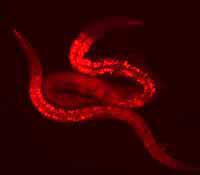Opposing fat metabolism pathways triggered by a single gene

Regulation of b-oxidation gene expression by nhr-49. Photo: Keith Yamamoto et al.
Regulating metabolism of fat is an important challenge for any animal, from nematodes to humans. Central players in the regulatory network are the nuclear hormone receptors (NHRs), which are transcription factors that turn on or off a set of target genes when bound by specific lipid molecules. In the premier open-access journal PLoS Biology, Keith Yamamoto and colleagues show that the nuclear hormone receptor nhr-49 controls two different aspects of fat metabolism, which interact to form a feedback system controlling the consumption and composition of fats in the nematode.
Using RNAi to suppress gene expression, the researchers discovered that when nhr-49 was absent, the lifespan of the nematode was reduced by more than 50%, and the animal displayed numerous gross abnormalities in the gut and gonad. This was accompanied by unusually high fat content in the larvae. They further showed that deletion of nhr-49 changed expression of 13 genes related to fat and glucose metabolism, with the most dramatic effects occurring within two metabolic pathways: mitochondrial lipid oxidation and fatty acid desaturation.
Following up on these changes in gene expression, Yamamoto and colleagues show that in its normal actions, nhr-49 sets in motion two opposing pathways: it increases expression of a gene acs-2, which leads to reduction of fat content, and it increases expression of another gene fat-7, which, by reducing acs-2, increases fat content. In its function, nhr-49 resembles a mammalian NHR, called peroxisome proliferator-activated receptors (PPARs). Further investigation of this link may lead to better understanding of the functions of PPARs and provide opportunities for altering their function for treatment of fat metabolism disorders such as diabetes and obesity.
Media Contact
All latest news from the category: Life Sciences and Chemistry
Articles and reports from the Life Sciences and chemistry area deal with applied and basic research into modern biology, chemistry and human medicine.
Valuable information can be found on a range of life sciences fields including bacteriology, biochemistry, bionics, bioinformatics, biophysics, biotechnology, genetics, geobotany, human biology, marine biology, microbiology, molecular biology, cellular biology, zoology, bioinorganic chemistry, microchemistry and environmental chemistry.
Newest articles

Machine learning algorithm reveals long-theorized glass phase in crystal
Scientists have found evidence of an elusive, glassy phase of matter that emerges when a crystal’s perfect internal pattern is disrupted. X-ray technology and machine learning converge to shed light…

Mapping plant functional diversity from space
HKU ecologists revolutionize ecosystem monitoring with novel field-satellite integration. An international team of researchers, led by Professor Jin WU from the School of Biological Sciences at The University of Hong…

Inverters with constant full load capability
…enable an increase in the performance of electric drives. Overheating components significantly limit the performance of drivetrains in electric vehicles. Inverters in particular are subject to a high thermal load,…





















